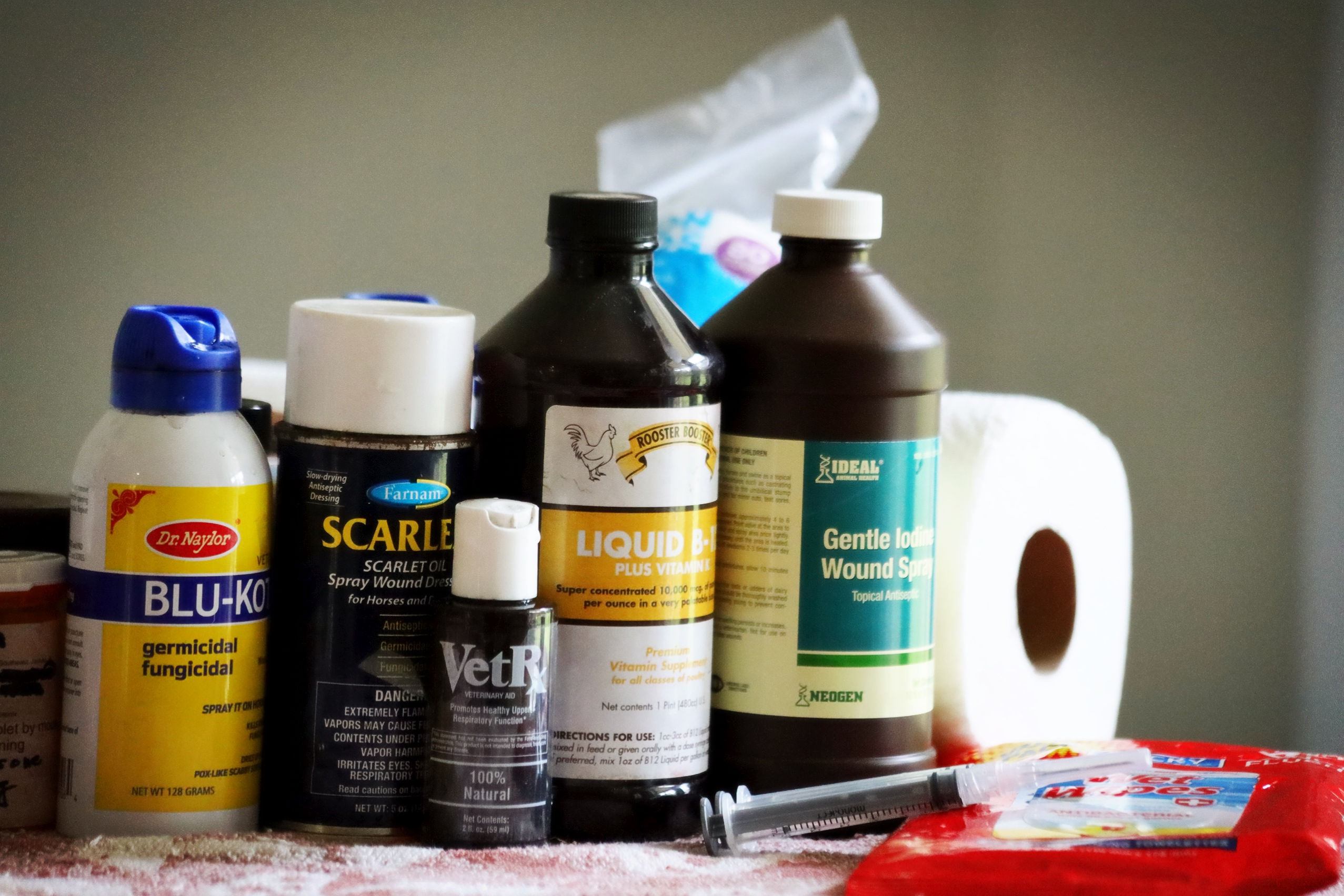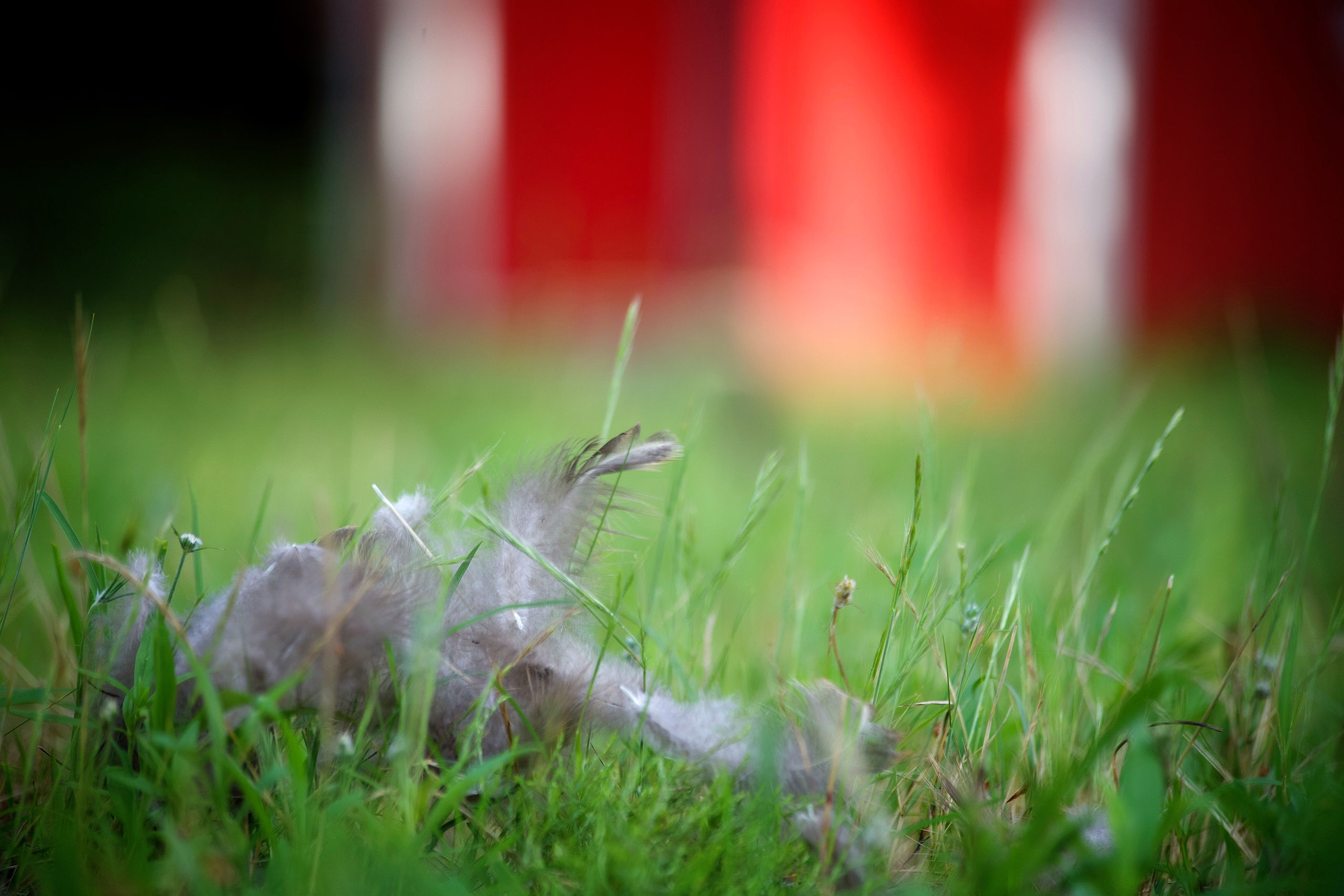Wounds are just an unfortunate, yet inevitable occurrence if you have animals. The best approach is being prepared. Chances are, you may be able to doctor up your chicken at home, without having to see a veterinarian or put the chicken down. Chickens can find some fun ways to hurt themselves, not to mention they are on the menu for pretty much every type of predator out there. You’ll likely come across a medical situation or two. Here is what to do if your chicken gets an injury, most specifically a flesh wound.
To make the process easier, it helps to already have the correct supplies on hand. You don’t need to purchase an overpriced first aid kit, when you can simply head to the feed store and put together your own. Here are a few essential items to keep in your first aid kit:
(Hoover’s is in no way affiliated with the following products, they are just some easily available essentials I personally have on hand.)

First Aid Kit:
Blu Kote
Red Kote
Vetericyn
Neosporin
Betadine
Beeswax Wraps
Latex Gloves
Paper towels, gauze, and vet tape
Tweezers and scissors
If allowed a clean and safe space to heal, chickens can recover from some of the most gruesome injuries. For example, we once had a beautiful beige Naked Neck hen who survived a hawk attack. We were able to scare the hawk off her, but she was left missing about a 6 x6 inch patch of skin missing! Her skin was literally gone and I could see her muscle tissue underneath! After a minute of panicking, I had to figure out what to do with this poor girl! It looked painful and I was scared she might not survive, but after isolation and applying antiseptic spray every day, she had re-grown all tissue and was back living her best life after about 3 weeks! She even eventually grew back feathers as well!
If your chicken has an open wound, laceration, or skin that has been damaged, here’s what to do!
- Isolate
To be best prepared, have a small kennel on hand. Isolating the injured bird is important for a fast recovery. Other chickens will often peck or bully an injured one. Be sure to keep the bottom of the cage dry with clean shavings. Avoid using any granular bedding that could get stuck in a wound. The chicken may do better in its kennel in a garage or barn, somewhere cool where you can regulary check in on it.
- Clean Wound with Antiseptics
After examining, carefully clean the wound. First wash gently with warm soap water, then gently pour some betadine over it. The bedadine is a natural antiseptic, commonly used in surgery. Gently remove any debris or dead skin. The betadine can be left on, or rinsed off. Betadine has a dark brown, staining color, which dries to a yellow stain over the skin. It can be left on, or rinsed off.
- Treat Medicinally
There are several medicinal options available for flesh wounds on poultry, most being available at your local feed store. One particular spray, called Vetericyn, is a great option. It is an antimicrobial spray that doesn’t sting when applied. It promotes healthy skin regrowth and does not have any egg withdrawal time!
Another option is Red Kote, which is available in a dobber or spray. Red Kote is another great wound antiseptic, and is best on a moist lesion. It can also be used to help treat scaly leg mites and bumble foot as well. However, it contains scarlet red oil which looks like blood. This only matters if you have not separated the injured bird from the flock. The red color can trigger the other chickens to peck. Pecking is a very serious problem, so be sure to isolate if using Red Kote.
A relative of Red Kote is Blu Kote. Made by the same makers of Red Kote, Blu Kote also comes in a dobber or aerosol spray. It contains a purple dye called violet gelatin. There is some debate on this product’s safety and egg withdrawal period. Despite this, it is one of the fastest and best sprays for wounds on chickens. The purple color actually deters other chickens from pecking and it leaves wounds dry. Blu Kote contains both antibacterial and antifungal properties.
Another great product, is plain Neosporin. The petroleum based antibiotic ointment probably is already in your medicine cabinet. Just be careful not to use Neosporin containing lidocaine, as this may be harmful to poultry. Neosporin is a great option if you are planning on wrapping the wound. Apply a good,thick layer to keep any cotton fibers from getting into the wound.
- 4. To Wrap, or Not to Wrap
If you are dealing with a flesh wound, sometimes the best option is leaving it to dry. Drying promotes scabbing and regrowth of skin. If the wound is missing skin, and hasn’t gone into the muscle, leave it to dry with a dry antiseptic spray, reapplied a few times a day.
If your chicken has a very deep, wet cut, you may prefer to wrap it. Be sure if you wrap the wound, to moisten whatever cotton pad with lots of medicine. You definitely do not want the cotton drying into the skin! Most feed stores carry beeswax wraps. These stretchy wraps secure to themselves, without the need for tape. Wrap the wound with light pressure, not allowing the wrap to become too tight, constricting bloodflow.
A wound on the back or chest should be wrapped with care to avoid being overly tight, yet still allow for some mobility.

- Observe
While a chicken is healing, keep her comfortable and quiet. Lightly cover part of her cage with a towel or blanket to reduce stress. You can give the chicken some added supplements (like Rooster Booster) or electrolytes to their water.If you can, check on the chicken several times a day and clean and rewrap the wound once everyday, at least. It can be a long road to recovery, but chances are, your chicken will ready to ready outside in a few weeks.
If you happen to experience a wounded chicken this year, try not to be discouraged. As chicken owners, we wear many hats, and sometimes that hat is one of emergency nurse! Good luck out there fellow chicken tenders!